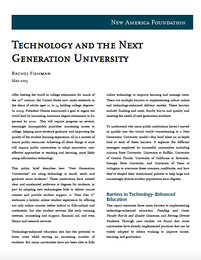Technology and the Next Generation University
Policy Paper

May 21, 2013
After besting the world in college attainment for much of the 20th century, the United States now ranks sixteenth in the share of adults ages 25 to 34 holding college degrees. In 2009, President Obama announced a goal to regain the world lead by increasing American degree attainment to 60 percent by 2020. This will require progress on several, seemingly incompatible priorities: increasing access to college, helping more students graduate, and improving the quality of the student learning experience, all in a context of scarce public resources. Achieving all these things at once will require public universities to adopt innovative, cost-effective approaches to teaching and learning, most likely using information technology.
This policy brief describes how “Next Generation Universities” are using technology to enroll, teach, and graduate more students. These institutions have created clear and accelerated pathways to degrees for students, in part by adopting new technologies both to deliver course content and provide student support. A “Next Gen U” embraces a holistic online student experience by offering not only online courses (either hybrid or fully-online) and credentials, but also student services like early warning systems, counseling and support, financial aid, and even library and research services.
Technology-enhanced education also has the potential to lower costs while serving an increasing number of students. But many universities have not been able to fully utilize technology to improve learning and manage costs. There are multiple barriers to implementing robust online and technology-enhanced delivery models. These barriers include: funding and costs; faculty buy-in and quality; and meeting the needs of next generation students.
To understand why more public institutions haven’t moved as quickly into the virtual world—transitioning to a Next Generation University model—this brief takes an in-depth look at each of these barriers. It explores the different strategies employed by successful universities including Arizona State University, University at Buffalo, University of Central Florida, University of California at Riverside, Georgia State University, and University of Texas at Arlington to overcome these common roadblocks, and how they’ve shaped their institutional policies to help large and increasingly diverse student populations earn degrees.